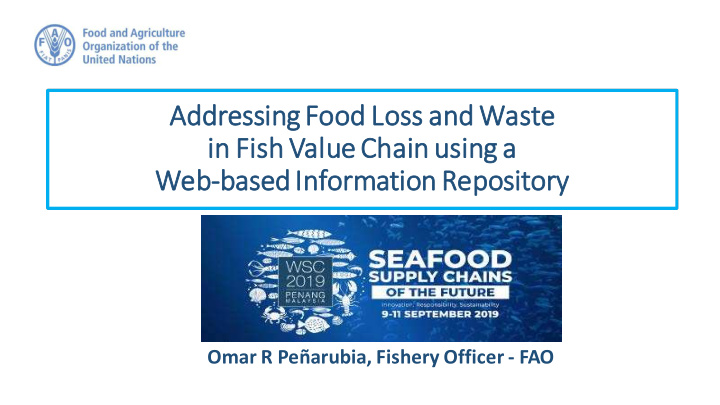



Addressing F Food ood Loss a oss and W Wast ste in Fi Fish V Value C Chain in u usin ing a a We Web-based I Info forma mation R Repository Omar R Peñarubia, Fishery Officer - FAO
World fish supply 171 m million tonnes (2016) Total export value: USD 1 152 billion (2017) World consumption per capita (2016): 20.3 K Kg 59.6 m million on employed worldwide Source: FAO. 2018. The State of World Fisheries and Aquaculture 2018 - Meeting the sustainable development goals. Rome.
27% of the 35% of the global global landings lost and 9-15% due to fish landings lost discarded at sea (2016) Roughly one third of the food produced in the world for human consumption every year gets lost or wasted: around 1.3 billion tonnes Source: FAO, 2011. Global food losses and food waste – Extent, Causes and Prevention
THE CAUSES OF FISH LOSS AND WASTE Processing Consumption Post Distribution Harvesting Harvest • Discards Excess • Lack of • • Infestation/ appropriate predation • Excess supply/ Lack of storage buyers • Poor quality • Fish falling from infrastructure raw material nets while hauling and services • Delays in sales • Predators while • Scarce or absent of Spoilage • in nets packaging • Poor quality packaging Discards • • Careless handling/ stacking • Low quality/ traditional • Poor processing technique • Delays handling/ Cold chain • Low • Long soaking and • Poor roads processing hauling back times and capacity Best Before? transport • Illegal fishing technique facilities Expiration date? • Infestation • Remoteness • Poor water /predation • Absence of of landing quality Consumer confusion • chilling on board sites
Skills and Knowledge Policy Environment ADDRESSING FISH LOSS AND WASTE Services and Infrastructure Appropriate technology
Reducing losses is an important development goal in the fisheries sector, and is globally recognized as a challenge that needs to be addressed. Reducing losses is not straightforward owing to the multiplicity of species, fishing gear and methods, as well as numerous dispersed and inaccessible landing sites especially in small-scale fisheries. Availability and Quality of Information Poor quality and often not produced or distributed in a timely manner. Poor quality of information leads to substandard guidelines o general sense of distrust on fishery information o results in very limited use or no use of this information
No single repository of loss scenarios and loss reduction options
Rationale: Outcome of 32nd session of COFI The Committee : highlighted the importance of reducing food waste and losses supported the development of an FAO technical guideline addressing the causes of and remedies to food losses and waste. • “Practical Guidance to Inform Policy on Addressing Common Loss Scenarios from Pre-harvest to Consumption Stages in Fisheries and Aquaculture Project” • was funded by the Norwegian Ministry of Trade, Industry and Fisheries
o 02 November 2017: Expert Consultation on the Development of a Global Fish Loss and Waste Repository to Inform Policy •Natural Resources Institute (Value Chains) •World Resources Institute (Food Loss & Waste) • WorldFish (Gender/losses) •UNIDO (Fish Marketing/Indonesia) Phase II •Tanzania Govt – (Africa/losses) •SEAFDEC (S E Asia/losses) Beta Site including selected content to be complete •Sustainable Food Chains at Wageningen University and and shared with users. Feedback to be curated and Research (Loss & Waste) •Vestergaard (Food Storage) incorporated into full site development. •Mindfully Wired (Web Information Resource) Repository content to be finalized for remaining value chain and loss scenarios o 26 May 2017: FAO Advisory Group’s Inception Meeting Beta Site to be fully updated per feedback from initial user testing as well as full value chain and loss scenario content March 2017 --------------------------------------------------------------------------------------------------------------May 2019
http://www.fao.org/flw-in-fish-value-chains/en/
Loss oss Scenarios Capture Fisheries Processing & Storage Wholesale Transport Retail Consumption Aquaculture Solutio ions
Website A Activ ivit ities a and T Traffic ic (6 May – 6 August 2019) Highlights • The website reached 2000 visitors and 2300 sessions since launch, and has been viewed by users in 129 countries • 8.33% of traffic came from ‘ Organic Search ’ (up from 7.6% in July). This audience is the most engaged group with an average session duration of 4 minutes and 06 seconds • About 10% of visitors have returned to our site. These visitors are highly engaged, viewing an average of 5 pages and spending 5 minutes on the site.
Next S t Ste teps • ‘Join Us’ page featuring the Newsletter, add a • Larger homepage call out about the Newsletter • Additional Loss Scenarios
Conclusion • Importance of reducing food waste and losses • Importance of an information repository
Thank k yo you v very mu y much Kin indly vis visit http://www.fao.org/flw-in-fish-value-chains/en/
http://www.fao.org/about/meetings/sus tainable-fisheries-symposium/en/
OBJECTIVES OF THE SYMPOSIUM • Enhance science and policy interaction to achieve sustainable fisheries • Develop a new vision for capture fisheries, which can respond to rapid changes in the environment and in our society in the 21st century • Support the implementation of the Sustainable Goal 14 • For more information and registration: http://www.fao.org/about/meetings/sust ainable-fisheries-symposium/en/
Recommend
More recommend